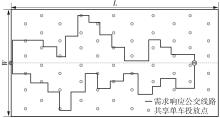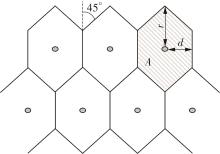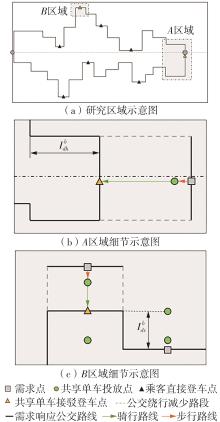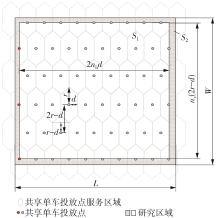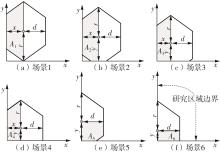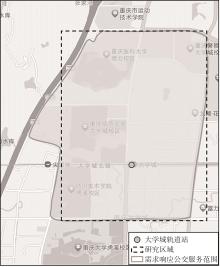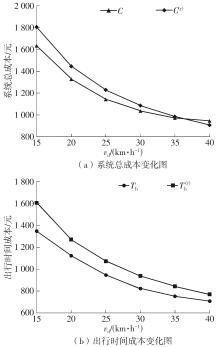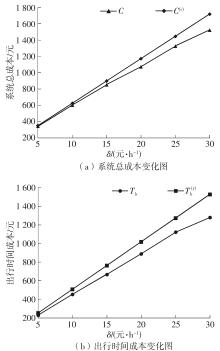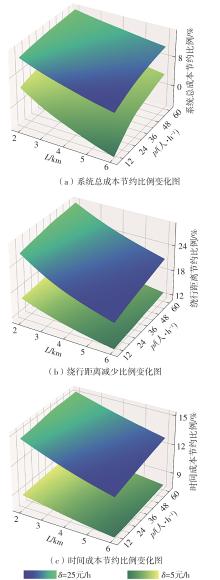Journal of South China University of Technology(Natural Science Edition) ›› 2025, Vol. 53 ›› Issue (8): 20-28.doi: 10.12141/j.issn.1000-565X.240455
• Intelligent Transportation System • Previous Articles Next Articles
Research on the Joint Optimization of Shared Bikes and Demand-Responsive Connector
XU Hang, LI Xin, YUAN Yun
- Transportation Engineering College,Dalian Maritime University,Dalian 116026,Liaoning,China
-
Received:2024-09-11Online:2025-08-25Published:2025-03-07 -
Contact:李欣(1985—),男,博士,教授,主要从事多模式公交系统研究。 E-mail:xtopli@dlmu.edu.cn -
About author:许航(1995—),女,博士生,主要从事多模式公交系统研究。E-mail: xuhangll@dlmu.edu.cn -
Supported by:the National Natural Science Foundation of China(52272317)
CLC Number:
Cite this article
XU Hang, LI Xin, YUAN Yun. Research on the Joint Optimization of Shared Bikes and Demand-Responsive Connector[J]. Journal of South China University of Technology(Natural Science Edition), 2025, 53(8): 20-28.
share this article
| [1] | CHEN Z, LIEROP V D, ETTEMA D .Dockless bike-sharing systems:what are the implications?[J].Transport Reviews.2020.40(3):333-353. |
| [2] | 饶传坤,雷思静 .厦门岛轨道交通站点共享单车接驳影响因素研究[J].浙江大学学报(理学版),2024,51(1):90-98. |
| RAO Chuankun, LEI Sijing .Study on the influencing factors of shared bikes connection to rail transit stations in Xiamen island[J].Journal of Zhejiang University (Science Edition),2024,51(1):90-98. | |
| [3] | 邓亚娟,刘霜,白钰,等 .共享单车与公共交通多元关系分类及阈值研究[J].交通运输系统工程与信息,2024,24(2):208-216. |
| DENG Yajuan, LIU Shuang, BAI Yu,et al .Classification and threshold research on multivariant relationship between shared bicycles and public Transit[J].Journal of Transportation Systems Engineering and Information Technology,2024,24(2):208-216. | |
| [4] | QIU W, CHANG H .The interplay between dockless bikeshare and bus for small-size cities in the US:a case study of Ithaca[J].Journal of Transport Geography,2021,96:103175/1-15. |
| [5] | LIU L, KONG H, LIU T,et al .Mode choice between bus and bike-sharing for the last-mile connection to urban rail transit[J].Journal of Transportation Engineering,Part A:Systems,2022,148(5):4022016/1-9. |
| [6] | SHI X, LI Z, XIA E .The impact of ride-hailing and shared bikes on public transit:moderating effect of the legitimacy[J].Research in Transportation Economics,2021,85:100870/1-8. |
| [7] | RADZIMSKI A, DZIĘCIELSKI M .Exploring the relationship between bike-sharing and public transport in Pozna’n,Poland[J].Transportation Research Part A:Policy & Practice,2021,145:189-202. |
| [8] | KONG H, JIN S, SUI D .Deciphering the relationship between bikesharing and public transit:modal substitution,integration,and complementation[J].Transportation Research Part D:Transport and Environment,2020,85:102392/1-20. |
| [9] | WU L, GU W, FAN W,et al .Optimal design of transit networks fed by shared bikes[J].Transportation Research Part B:Methodological,2020,131:63-83. |
| [10] | CHENG L, HUANG J, JIN T H,et al .Comparison of station-based and free-floating bikeshare systems as feeder modes to the metro[J].Journal of Transport Geography,2020,107:103545/1-11. |
| [11] | LIU L, SUN L, CHEN Y,et al .Optimizing fleet size and scheduling of feeder transit services considering the influence of bike-sharing systems[J].Journal of Cleaner Production,2019,236:117550/1-15. |
| [12] | BRUZZONE F, SCORRANO M, NOCERA S .The combination of e-bike-sharing and demand-responsive transport systems in rural areas:a case study of Velenje[J].Research in Transportation Business and Management,2021,40:100570/1-17. |
| [13] | 李欣,滕章华,许航,等 .需求响应公交和共享单车联合出行系统优化[J].交通运输工程与信息学报.2024,22(2):21-33. |
| LI Xin, TENG Zhanghua, XU Hang,et al .Optimization design a demand-responsive transit-bike joint service[J].Journal of Transportation Engineering and Information,2024,22(2):21-33. | |
| [14] | YANG H, ZHANG Z, FAN W,et al .Optimal design of demand responsive connector service considering elastic demand[J].IEEE Transactions on Intelligent Transportation Systems,2021,22(4):2476-2486. |
| [15] | LI X, LI Y H, LIU W Y,et al .Optimal design of pure battery electric bus system on the grid network[J].Transportmetrica A:Transport Science,2024,20(2):2152298/1-34. |
| [16] | LI X, LUO Y, LI Y H,et al .A joint optimisation model for designing demand responsive connectors fed by shared bikes[J].Transportmetrica A:Transport Science,2023,19(2):2025949/1-25. |
| [17] | 范文博,唐慧祥,杨鸿泰,等 .考虑乘客起讫点选择的可变线路公交服务设计优化[J].交通运输工程与信息学报,2024,22(3):52-67. |
| FAN Wenbo, TANG Huixiang, YANG Hongtai,et al .Design optimization of flex-route transit services considering passengers' departure and destination choice[J].Journal of Transportation Engineering and Information,2024,22(3):52-67. | |
| [18] | QUADRIFOGLIO L, LI X .A methodology to derive the critical demand density for designing and operating feeder transit services[J].Transportation Research Part B:Methodological,2009,43:922-935. |
| [19] | XIE W, OUYANG Y .Optimal layout of transhipment facility locations on an infinite homogeneous plane[J].Transportation Research Part B:Methodological,2015,75:74-88. |
| [1] | HU Baoyu, QI Yue, JIA Dianjing, CHENG Guozhu. Joint Optimization of Loop Line Electric Bus Vehicle Scheduling and Driver Scheduling [J]. Journal of South China University of Technology(Natural Science Edition), 2025, 53(6): 91-103. |
| [2] | SU Yuejiang, WEN Huiying, YUAN Minxian, et al. Travel Carbon Emission Prediction Model Based on Resident Attribute Data [J]. Journal of South China University of Technology(Natural Science Edition), 2024, 52(8): 23-33. |
| [3] | YANG Yazao, WENG Tangzheng. Impact of Spatiotemporal Constraints on Active Travel [J]. Journal of South China University of Technology(Natural Science Edition), 2024, 52(2): 113-123. |
| [4] | ZHUANG Yan, DONG Chunjiao, MI Xueyu, et al.. Identification of Accident Black Spots Based on Improved Network Kernel Density and Negative Binomial Regression [J]. Journal of South China University of Technology(Natural Science Edition), 2024, 52(1): 119-126. |
| [5] | ZHAO Xiaomei, HAO Guoyu, NIU Xiaojing, et al.. Traffic Boundary Control Strategy Based on Macroscopic Fundamental Diagram Under Different Rainfall [J]. Journal of South China University of Technology(Natural Science Edition), 2024, 52(1): 72-82. |
| [6] | HU Xinghua, CHEN Xinghui, WANG Ran, et al. Optimization Model of Bus Priority Control Considering Carbon Emissions with Stochastic Characteristics [J]. Journal of South China University of Technology(Natural Science Edition), 2023, 51(10): 160-170. |
| [7] | XU Lunhui, YU Jiaxin, PEI Mingyang, et al. Repositioning Strategy for Ride-Hailing Vehicles Based on Geometric Road Network Structure and Reinforcement Learning [J]. Journal of South China University of Technology(Natural Science Edition), 2023, 51(10): 99-109. |
| [8] | SHEN Yutong, LI Ming, CUI Zhiyong, et al. Study on the Multi-Period Allocation Method of Vehicle Resource in Hybrid Service Mode [J]. Journal of South China University of Technology(Natural Science Edition), 2023, 51(10): 89-98. |
| [9] | WANG Hao, XIE Ning . Coordinated Optimization Model of Arterial Segmented Green Waves Considering the Efficiency of Tram Operation [J]. Journal of South China University of Technology(Natural Science Edition), 2023, 51(1): 95-105. |
| [10] | ZHAO Jiandong, ZHU Dan, LIU Jiaxin. Metro Transfer Passenger Flow Prediction Based on STL-GRU [J]. Journal of South China University of Technology(Natural Science Edition), 2022, 50(5): 22-31. |
| [11] | WU Jiaorong XIE Jinhong WANG Yuqin. Profiling Method of Instability of Bus Route Operation and the Corresponding Application [J]. Journal of South China University of Technology(Natural Science Edition), 2022, 50(2): 15-22. |
| [12] | CHEN Xiaohong, HU Fang . Interval Optimization Model of Signal Control at Intersection Based on Possibility Degree [J]. Journal of South China University of Technology(Natural Science Edition), 2022, 50(10): 29-40. |
| [13] | YU Lijun. Generalized System-Optimal Traffic Assignment with Link Capacity Constraints [J]. Journal of South China University of Technology(Natural Science Edition), 2021, 49(4): 140-148. |
| [14] | YAO Enjian LU Muyang LIU Yuhuan YUAN Ling. Electric Bus Area Driving Plan Preparation Considering Charging Constraints [J]. Journal of South China University of Technology(Natural Science Edition), 2019, 47(9): 68-73. |
| [15] | LIU Zhongbo ZHAO Xiaohui. A Dynamic Allocation and Guidance Model for Parking Spaces with Minimum Total Parking Costs#br# [J]. Journal of South China University of Technology(Natural Science Edition), 2018, 46(9): 92-98. |
| Viewed | ||||||
|
Full text |
|
|||||
|
Abstract |
|
|||||
